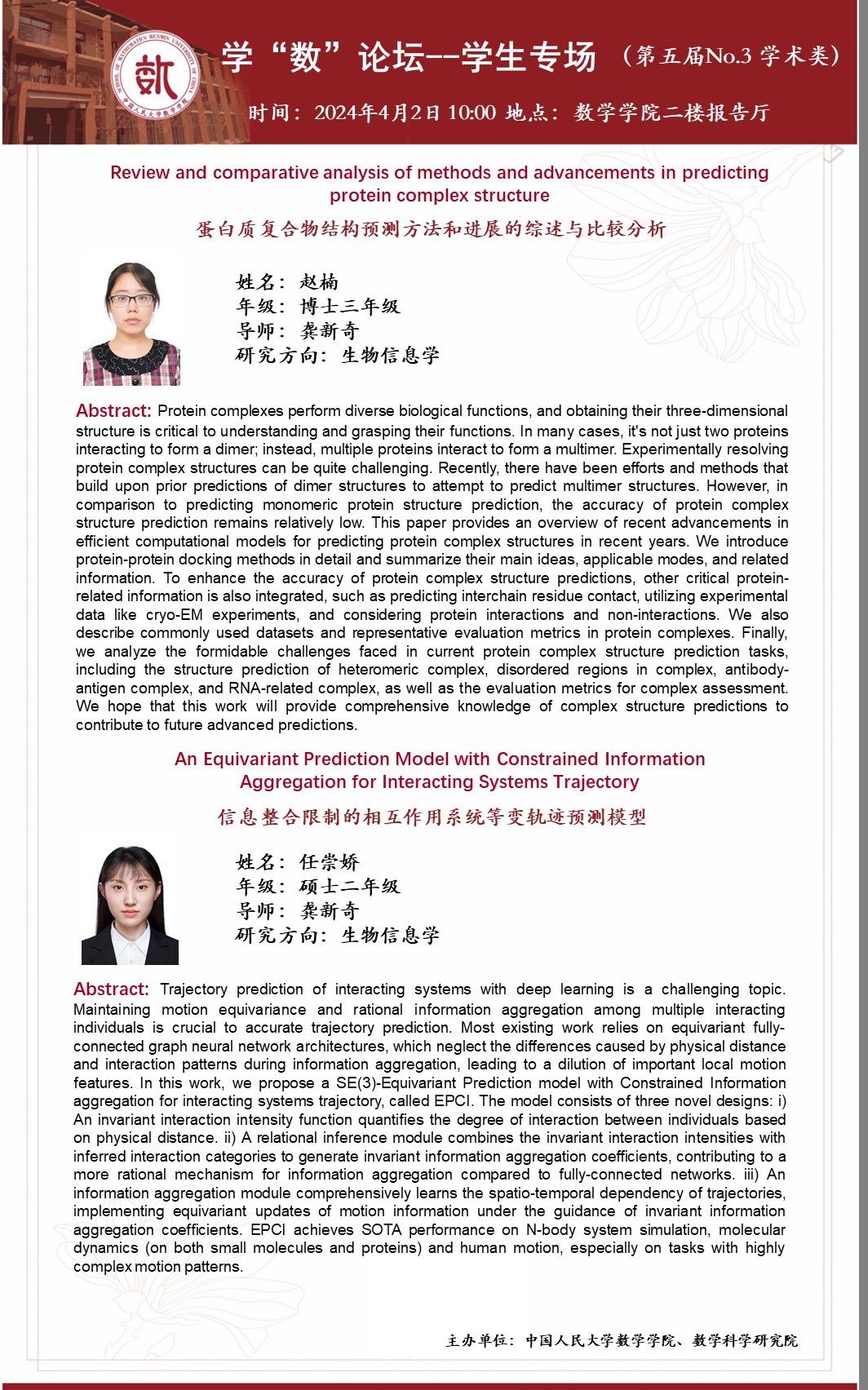第五届学“数”论坛——学生专场第三期(学术类)预告
大家好,本届学“数”论坛——学生专场的第三场报告来啦!本场报告类型为学术类,将于2024年4月2日10:00在数学学院二楼报告厅举办。主讲嘉宾为硕士二年级的刘一博、任崇娇和博士三年级的韩冰清、赵楠同学。
刘一博同学师从我院张倩伟老师,主要研究方向是新型交叉效率; 联盟内外部效应; 参与者权重; Shapley 值; 资源分配。本次报告题目为《基于新型交叉效率的资源分配机制》,
报告内容主要如下:
In this paper, we combine Data Envelopment Analysis (DEA) with cooperative game theory to create a fair resource allocation mechanism in alliances. We introduce a novel cross-efficiency measure that considers both internal and external effects within alliances. Weight assignments are used to reflect the importance of internal and external DMUs. We establish a cooperative game characteristic function based on this cross-efficiency, show the super-additivity of the characteristic function and prove the core non-emptiness of the cooperative game. Finally, we design a resource allocation mechanism using the Shapley value based on the characteristic function and demonstrate its practical application through a numerical example and an empirical analysis.
韩冰清同学师从我院龚新奇老师,主要研究方向是生物信息学。本次报告题目为《ABAG-docking benchmark:用于抗体-抗原计算对接的非冗余结构基准数据集
》,
报告内容主要如下:
Accurate prediction of antibody–antigen complex structures is pivotal in drug discovery, vaccine design and disease treatment and can facilitate the development of more effective therapies and diagnostics. In this work, we first review the antibody–antigen docking (ABAG-docking) datasets. Then, we present the creation and characterization of a comprehensive benchmark dataset of antibody–antigen complexes. We categorize the dataset based on docking difficulty, interface properties and structural characteristics, to provide a diverse set of cases for rigorous evaluation. Compared with Docking Benchmark 5.5, we have added 112 cases, including 14 single-domain antibody (sdAb) cases and 98 monoclonal antibody (mAb) cases, and also increased the proportion of Difficult cases. Furthermore, we provide details on the process of building the benchmark dataset and introduce a pipeline for periodic updates to keep it up to date. We also utilize multiple complex prediction methods for testing and analyzing this dataset. This benchmark serves as a valuable resource for evaluating and advancing docking computational methods in the analysis of antibody–antigen interaction, enabling researchers to develop more accurate and effective tools for predicting and designing antibody–antigen complexes.
赵楠同学师从我院龚新奇老师,主要研究方向是生物信息学。本次报告题目为《蛋白质复合物结构预测方法和进展的综述与比较分析》,
报告内容主要如下:
Protein complexes perform diverse biological functions, and obtaining their three-dimensional structure is critical to understanding and grasping their functions. In many cases, it's not just two proteins interacting to form a dimer; instead, multiple proteins interact to form a multimer. Experimentally resolving protein complex structures can be quite challenging. Recently, there have been efforts and methods that build upon prior predictions of dimer structures to attempt to predict multimer structures. However, in comparison to predicting monomeric protein structure prediction, the accuracy of protein complex structure prediction remains relatively low. This paper provides an overview of recent advancements in efficient computational models for predicting protein complex structures in recent years. We introduce protein-protein docking methods in detail and summarize their main ideas, applicable modes, and related information. To enhance the accuracy of protein complex structure predictions, other critical protein-related information is also integrated, such as predicting interchain residue contact, utilizing experimental data like cryo-EM experiments, and considering protein interactions and non-interactions. We also describe commonly used datasets and representative evaluation metrics in protein complexes. Finally, we analyze the formidable challenges faced in current protein complex structure prediction tasks, including the structure prediction of heteromeric complex, disordered regions in complex, antibody-antigen complex, and RNA-related complex, as well as the evaluation metrics for complex assessment. We hope that this work will provide comprehensive knowledge of complex structure predictions to contribute to future advanced predictions.
任崇娇同学师从我院龚新奇老师,主要研究方向是生物信息学。本次报告题目为《信息整合限制的相互作用系统等变轨迹预测模型》,
报告内容主要如下:
Trajectory prediction of interacting systems with deep learning is a challenging topic. Maintaining motion equivariance and rational information aggregation among multiple interacting individuals is crucial to accurate trajectory prediction. Most existing work relies on equivariant fully-connected graph neural network architectures, which neglect the differences caused by physical distance and interaction patterns during information aggregation, leading to a dilution of important local motion features. In this work, we propose a SE(3)-Equivariant Prediction model with Constrained Information aggregation for interacting systems trajectory, called EPCI. The model consists of three novel designs: i) An invariant interaction intensity function quantifies the degree of interaction between individuals based on physical distance. ii) A relational inference module combines the invariant interaction intensities with inferred interaction categories to generate invariant information aggregation coefficients, contributing to a more rational mechanism for information aggregation compared to fully-connected networks. iii) An information aggregation module comprehensively learns the spatio-temporal dependency of trajectories, implementing equivariant updates of motion information under the guidance of invariant information aggregation coefficients. EPCI achieves SOTA performance on N-body system simulation, molecular dynamics (on both small molecules and proteins) and human motion, especially on tasks with highly complex motion patterns.


诚邀各位同学前来参加,与大家共同探讨,相互交流!
文案&海报/李清晨